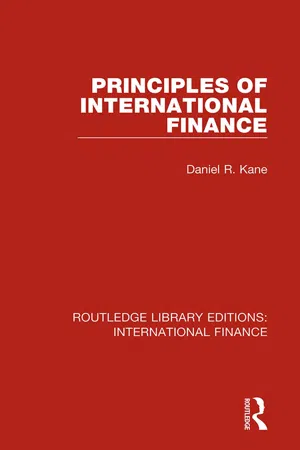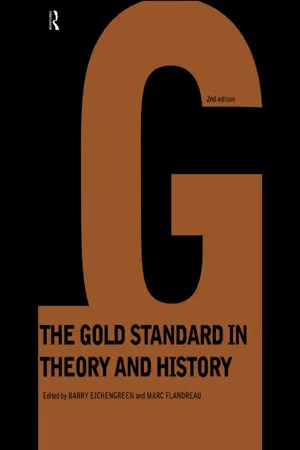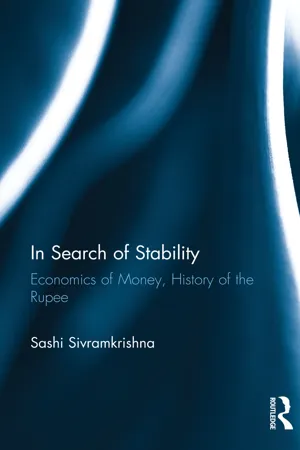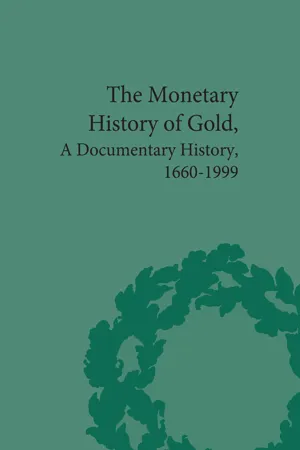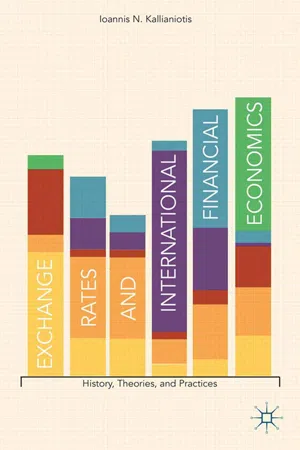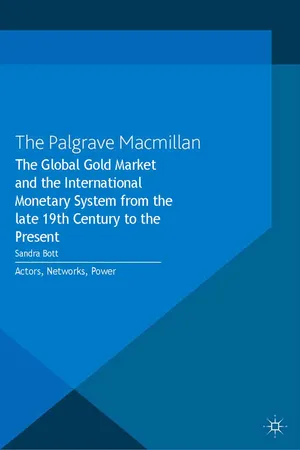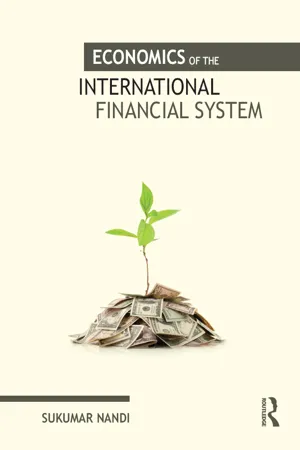Economics
Gold Exchange Standard
The Gold Exchange Standard was a monetary system where a country's currency was directly convertible into a fixed amount of gold, and other countries held their reserves in the form of the currency of the country with the largest gold reserves. This system was prevalent in the early 20th century and aimed to stabilize exchange rates and facilitate international trade.
Written by Perlego with AI-assistance
Related key terms
Related key terms
1 of 4
Related key terms
1 of 3
12 Key excerpts on "Gold Exchange Standard"
- eBook - ePub
- Daniel R. Kane(Author)
- 2018(Publication Date)
- Routledge(Publisher)
Part TwoExchange Rate Systems
Exchange rate systems establish the structural framework within which foreign exchange transactions are conducted.Systems are essentially either inflexible, in which case the exchange rate is stabilised within predetermined limits, or flexible, in which case the exchange rate is free to respond to changes in market forces.Various exchange rate systems have been resorted to (at times through default) in different periods. Each has met with varying degrees of success, prompted in part by the advantages and disadvantages inherent in each system and in part by the prevailing economic climate. Chapters 4 to 7 examine these systems within a chronological framework which reflects the changing nature of these economic conditions.Passage contains an image
4
The Gold StandardThe golden era of the gold standard was 1880–1914, when it was recognised and subscribed to by most of the industrialised world. The system was centred on the UK which was the dominant industrial and trading power of the time and which had operated a gold standard since the early nineteenth century. The outbreak of the First World War in 1914 brought the system to an end, but its perceived successes fostered attempts in the immediate post-war period to restore it to its former prominence. The subsequent return to the gold standard by the UK in 1925, and by most other countries by 1927, proved short-lived, however, not least because of the problems of misaligned exchange rates and the less than propitious international financial climate. This, together with a succession of financial crises, prompted the UK to abrogate the gold standard in 1931. The US followed in 1933 and France in 1936, so that by the end of the decade the gold standard had been abandoned and consigned to the annals of economic history. - eBook - ePub
- Barry Eichengreen, Marc Flandreau(Authors)
- 2005(Publication Date)
- Routledge(Publisher)
1 It is interesting to compare these figures with the comparable items for the United States. (The American returns also include other figures reducing their total net liability, which we have not yet been able to collect for Great Britain.)* From Cmd. 3897, London, HMSO, 1931, pp. 18–24, 106–14, abridged.Passage contains an image
14The Gold Exchange Standard
Ragnar Nurkse*Among the various schemes and proposals which repeatedly crop up in discussions of monetary reform, one that has enjoyed a wide appeal is the idea of an international currency system with exchange rates stable, as under the gold standard, but with liquid foreign balances constituting the international means of settlement and the international monetary reserves. Gold, it has been suggested, could be dispensed with in such a system not only as a means of international payment but also as a standard of value, especially if the currency or currencies in which the reserves were held were maintained reasonably stable in terms of goods and services.Monetary history has furnished many examples of the exchange standard principle. Indeed, the practical application of this principle must find a place in any account, however condensed, of international monetary relations during the interwar period. The gold standard that was ‘restored’ in the 1920s was in the main a gold exchange standard. But an exchange standard need not be a gold exchange standard; the sterling area which emerged from the currency chaos of the Great Depression in the 1930s is another important example of the exchange reserve system.Origin and growth
The recommendations of the Genoa Conference
The adoption of a Gold Exchange Standard was officially recommended by the Genoa Conference, which met in the spring of 1922 to consider the problems of financial reconstruction. This recommendation was based on the view that there existed a shortage of gold, due both to a decline in current supply and to an actual or prospective increase in demand for monetary purposes. - eBook - ePub
- H. L. Puxley(Author)
- 2017(Publication Date)
- Routledge(Publisher)
The Gold Standard and its Future, London, 1932, p. 9. With stable exchange rates, an American trader can deal in goods priced in sterling as simply as in goods priced in dollars.1 “The quantity of circulating credit tends to hold a definite relation to the quantity of money in circulation.”—Irving Fisher, Purchasing Power of Money, p. 50. The quantity of money in circulation, in turn, was supposed to be closely linked to the size of the country’s gold holdings.1 “Any fall in the value of gold in one country (indicated by a rise in prices in that country) relative to the value of gold in other gold-standard countries would generate a movement of gold out of that country into those other countries where its values are greater. Inflow to those countries would tend to lower its value there, i.e. to raise prices; and the efflux from the country which lost some of its gold would tend to raise its value in that country, i.e. to lower prices. And these two sets of forces would continue to be effective until equilibrium was restored…. In short, the operation of the gold standard … tended to establish a price-stability between countries.”—D. T. Jack, Economics of the Gold Standard, London, 1925, p. 25.1 “The Territorial Distribution of money is effected through the agency of Prices. If the stock of money in any country becomes so large that, its rate of movement being what itis, goods offered in the market for money can be exchanged as often as required, and yet a higher level of prices be maintained than in other countries, that country becomes a good country to sell to, because prices there are high, and, for the same reason, becomes a bad country to buy from. The immediate consequence is that exports of domestic products from a country having such a scale of prices are diminished, while its imports of foreign merchandise are increased. If, then, the money of that country is such as has equal acceptance in foreign countries, a movement for its exportation to settle the disturbed balance of exchange at once begins.”—F. A. Walker, Money, Trade and Industry - eBook - ePub
In Search of Stability
Economics of Money, History of the Rupee
- Sashi Sivramkrishna(Author)
- 2016(Publication Date)
- Routledge(Publisher)
F , then F may now receive (say) 0.9 oz. instead of 1 oz. of gold at the old rate] but also because the element of uncertainty over future rates would creep in. The repercussions on trade and capital flows may be of utmost importance to both F and D.The most important function of the international gold standard was that it established precise parities between national currencies, fluctuations were then restricted to the import and export points. To make the system functional, the currencies had to be freely converted into gold and allowed to move freely between countries on the standard. The international gold standard minimizes the disturbing effects which the plurality of national currencies can have upon international commercial and financial relations. In other words, it provided the best alternative to an international or world currency.Reserves served an important purpose under the gold standard. Reserves were required primarily as a backing for currency in circulation and avoidance of a crisis in confidence. To an extent, therefore, reserves prevented an over-issue of currency and inflation; however, it is in the external sector that these reserves become crucial. Reserves were not merely to ‘guarantee’ the ‘value’ of bank notes but also to maintain international monetary stability by providing for gold export in case of a deficit in the balance of payments. However, such reserves would have to be replenished so that its effect could be transmitted to the domestic real economy; a monetary contraction would then mean a slowdown in the real economy and correction in the balance of payments. Reserves must not be seen as a way of sustaining perpetual deficits; their role was to ensure that the adjustment mechanism or the rules of the game were transmitted to the real economy in order to correct long-terms imbalances in the balance of payments. - eBook - ePub
The Monetary History of Gold
A Documentary History, 1660-1999
- Mark Duckenfield(Author)
- 2016(Publication Date)
- Routledge(Publisher)
Section II.The Heyday of the Gold Standard, 1820–1930 Section II.The Heyday of the Gold Standard, 1820–1930Between 1820 and 1914, the gold standard went from being only Britain’s preferred monetary arrangement to being the keystone of the world’s monetary system. In 1930, despite the intervention of what was then the most destructive war in human history, all the major currencies in the world were once again linked to each other – seemingly in perpetuity – through their fixed values in gold. The exchange rate and price stability that existed among gold standard countries allowed for an unparalleled number of financial transactions and trading opportunities. The increased flows of capital and goods marked this era as the first age of globalisation, rivalling and predating the existing one today. This century of international financial integration was the high point of the gold standard.A rigid set of domestic institutions and loose international norms provided a framework for the smooth operation of the traditional gold standard. A free market economy coupled with strong legal protections for property rights allowed the gold standard to seamlessly transmit the ebbs and flows of international trading and financial relationships into the domestic economy. Political parties committed to limited government, laissez faire economic policies and balanced budgets ensured that the state’s fiscal position did not undermine its monetary commitments. Internationally, the balance of power between the major nation-states of Europe provided an environment conducive to an unprecedented period of peace and prosperity that covered the century between Waterloo and the beginning of the First World War.The international gold standard worked through what David Hume had earlier identified as the price-specie-flow mechanism.1 - eBook - ePub
Exchange Rates and International Financial Economics
History, Theories, and Practices
- J. Kallianiotis(Author)
- 2013(Publication Date)
- Palgrave Macmillan(Publisher)
The above exchange rate regime, which was negotiated at Bretton Woods and monitored by the IMF worked relatively well during the post-World War II period of reconstruction and rapid growth in world trade and in domestic economies. Of course, differences existing in national monetary, fiscal, and trade policies, as well as in inflation and unemployment rates among countries, and many external shocks (wars, oil prices, etc.) led the system to its demise. Actually, it was a rigid monetary system, which caused serious problems mostly to small economies. The US dollar was the main reserve currency held by central banks, but it had many problems because the United States ran persistent and growing deficits in its trade accounts. An enormous capital outflow of dollars to finance the deficits and the demand for dollars resulted in a lack of confidence by foreigners toward the ability of the United States to meet its commitment, which was to offer gold and keep the exchange rate fixed. The United States lost a tremendous amount of gold until the suspension of the official sales of gold in 1971. The dollar was devalued until March 1973, when the major foreign exchange markets closed for a few weeks, and when they reopened, currencies were allowed to float depending on the market conditions.A country on the “gold standard” and on the “Gold Exchange Standard” allowed its residents and its businesses to ship gold abroad to finance their payment deficits. The central banks also were buying or selling gold by accepting their own currencies. Gold was serving as the principal reserve asset up to 1971, when President Nixon abandoned the sale of gold from the Federal Reserve System. In the late years of the gold standard system, some countries began holding reserves in the form of currencies (mainly pound sterlings; later dollars; and now dollars, euros, and other hard currencies). The gold standard was imposing adjustment obligations and was also providing an adjustment mechanism (through the price-specie-flow mechanism, interest rate effects on capital flows, income effects, and terms of trade effects). Loss of gold signified the obligation to accept monetary contraction and a gain of gold implied an obligation to expand money supply. Gold was provided as the world’s monetary base during that period, “the golden age” period. There was a period of thriving international capital market intermediating funds mainly from United Kingdom and France to investors in the lands of recent settlement and elsewhere (in regions that nations were financing their wars of independence). But, the inflexibility of these systems caused serious balance-of-payments problems and consequently, employment and welfare reductions. - eBook - ePub
Balance of Payments
Theory and Economic Policy
- Robert Stern(Author)
- 2017(Publication Date)
- Routledge(Publisher)
4 Balance-of-Payments Adjustment Under the Gold StandardIt will be recalled from our earlier discussion that the gold standard is a system in which the rates of exchange are determined by the legally established mint-parity relationships of individual currencies in terms of gold. Exchange rates are not completely fixed by such relationships, however, because of transactions costs involved in the buying and selling of gold. Rather, the rates are constrained at the gold-export and import points, but can vary freely within the relatively narrow confines of these points. It will be recalled further that, in the idealized version of the gold standard, the domestic money supply was supposed to respond passively to the inflow or outflow of gold, and that monetary policy was supposed to reinforce the effects of gold movements on the money supply, depending upon the extant banking-reserve rules. Finally for adjustment to occur, wages, prices, and the rate of interest were assumed to respond to the monetary changes with the result that the balance of trade and the flow of international short-term capital would be altered until gold flows ceased and balance-of-payments equilibrium was restored.The Mechanism of Adjustment under the Gold Standard
In discussing the mechanism of adjustment under the gold standard, let us refer back to the disequilibrium situation depicted earlier in Figure 2.7 in our discussion of exchange-rate determination. It will be recalled that given the initial equilibrium indicated at P, and assuming an increase in the demand for pounds represented by the shift fromD £ atoD £, with an implied exchange rate of OT it would be cheaper to obtain pounds by means of exporting gold. The new equilibrium will be at C, wherea 'D £and the supply schedule, which is now perfectly elastic, intersect at the gold-export point. The outflow of gold is equal to HF in pounds, or HECF in dollars. It is presumed that in the country exporting gold there will be a reduction in the money supply and, as prices decline domestically, in the level of money income. The demand and supply schedules of pounds will consequently be shifted to the left and right respectively until the gold movement has stopped and the balance of payments restored to equilibrium. This new equilibrium will be located below the gold-export point where the new schedules (not drawn) intersect. The opposite pattern of adjustment is presumed to occur for the country receiving gold.1a ' - eBook - ePub
Good Money, Part I
Volume Five of the Collected Works of F.A. Hayek
- Stephen Kresge(Author)
- 2020(Publication Date)
- Routledge(Publisher)
ONE A SURVEY OF RECENT AMERICAN WRITING: STABILIZATION PROBLEMS IN Gold Exchange Standard COUNTRIES1It may seem surprising to Europeans, who envy the United States for the solidity of its gold currency, that the imperfection of the existing mone tary organization is felt more strongly there at present than in any other country. Yet it is a fact that the best American economists are devoting themselves primarily to the task of circumventing the dangers with which these flaws confront the country. In most European countries, where gold currencies have collapsed, the problems created by monetary instability could be attributed to deviations from the gold standard. In the United States, however, where, in contrast to most other countries, gold currency has remained intact, the intrinsic weaknesses of the gold exchange system have manifested themselves most clearly. The relative stability of the gold currencies in the prewar period, which rested on the free movement of gold and on the competition of central banks for gold, has now vanished. As long as the gold standard is maintained in its present form, the United States will continue to be faced with a steady influx of gold, which threat ens to overwhelm them with enormous price increases. This could easily lead to the opposite reaction, once European economies have recovered sufficiently to reverse the flow of gold in their direction. Only halfhearted and purely provisional measures have been mounted against this threat. In the face of present conditions, a decisive change must soon be intro duced. It is in any case highly unlikely that the relative stability of the prewar period will ever again be attained. American economists are therefore actively pursuing more or less radical plans to reform the obso lete gold exchange system.The true center of this attack and criticism is not the specific form of the gold exchange system but the organization of the monetary system as such. Therein seems to lie the seed for serious economic disruptions and business crises, as long as it is kept in its present guise. Reform must concentrate on this target if human production is to stabilize and the abundance of goods is to be increased to its maximum. According to Fos ter and Catchings,2 - eBook - ePub
- S. Bott, S. Bott, S. Bott(Authors)
- 2013(Publication Date)
- Palgrave Macmillan(Publisher)
laissez faire Liberalism was beginning to hold sway, especially at the centre of the world economy in London. The gold standard appeared as essential for what Karl Polanyi called ‘the Great Transformation’, and Christopher Bailey ’the Great Acceleration’, of international trade and finance since it was supposed to force governments to abide by the laws of supply and demand rather than be pushed by temporary political exigencies (Polanyi 1944; Bayley 2004, p 472). The gold standard also allowed the City of London to become the nerve centre of not only the British Empire but the entire world economy. London’s financial supremacy assured sufficient British earnings on ‘invisibles’ to allow it to enjoy balance of payments surpluses even while its trade balances were negative. That, in turn, stimulated the globalization of the world economy, as Britain’s profits from finance, transport, and commerce allowed the islanders to be the world’s largest consumers of many of the most important internationally traded commodities (Topik and Wells 2012, pp. 593–812).The gold standard also played a political/ideological role: the money supply and exchange rates were supposed to be governed mechanically by international balances of payment, that is by the market rather than by the caprice of politicians. This was the first step in what today is sometimes called ‘the imperialism of economics’ – the notion that the economic trumps the political because it is more scientific, unbiased, predictable and efficient. Adoptions of the gold standard in both Brazil and Mexico were early day manifestations of ‘structural readjustment’ before the term itself was coined. In both countries men considering themselves economic scientists (they adopted the label cientifico in Mexico), pushed for the gold standard (María y Campos 1979, 157–87; Casasús 1905; Murtinho 1899).A common notion holds that the gold standard was almost natural, long-standing and widely recognized, as if all state leaders had studied the same economics text book and diligently applied its principles. In fact, the gold standard only came to dominate in Europe after 1870, and particularly in the early 20th century. Gold, silver, and bimetal systems, both convertible and inconvertible, finally converged with the unprecedented boom in the world economy in the last quarter of the 19th century.But this convergence did not merely reflect the internal logic of capitalist accumulation. It arose from a number of different directions, at different periods, because of diverse internal and external reasons. Some of the greater agreement about value came from broad changes that Kevin O’Rourke and Jeffrey Williamson point to as the beginning of modern globalization; they argue that a transportation revolution, large-scale immigration and lowered transaction costs brought about price and factor convergence in the years between 1870 and 1930 (O’Rourke and Williamson 1999; also see Schwartz 1994). By helping lower transaction costs because of greater trust in the value of money and at the same time spreading and speeding commercial relations across national borders, the gold standard can be seen as both a cause and - eBook - ePub
- Sukumar Nandi(Author)
- 2017(Publication Date)
- Routledge India(Publisher)
The classical gold standard emerged as a true international standard by 1880 when a majority of independent countries agreed to switch from bimetallism, silver monometallism and paper to gold as the basis of their currencies. The key rule was maintenance of gold convertibility at the established par. When the countries adhered to the fixed price of gold vis-à-vis their currencies and maintained it, it amounted to a fixed exchange rate. According to recent evidence, the exchange rates throughout the period 1880–1914 were characterized by a high degree of fixity of the main countries, and violations of gold-parity points and devaluation was rare. The stability in the price of gold and the ease in the supply of gold compared to the world demand did facilitate this situation. The period was an ideal example of classical full-employment equilibrium situation in the industrial world with real income changing very little, and so the increase in the demand for monetary gold was small enough to be met by the available production and supply.According to established literature, a time-consistent credible commitment mechanism is necessary for an international monetary arrangement to be effective among the countries. The adherence to the gold convertibility rule provided such a mechanism. Also, apart from the reputation of the domestic gold standard and the constitutional provisions regarding the same, some other mechanisms like improved access to international capital market, the operation of the rules of the game, and the hegemonic power of England might have enforced the countries to adhere to the international gold standard rules.The main countries at the time realized that gold standard did provide improved access to the international capital markets and hence the support for the regime increased. Also, countries believed that gold convertibility would be a signal to creditors of sound government finance. Again, this had been the case for both developing and developed countries seeking access to long-term capital, such as Austria, Hungary and Latin America. Japan also used short-term loans to finance the Russo-Japanese war during 1905–06. The example of England being on the gold standard was an added attraction for other countries to be on the same standard. In fact, England had been the centre of the world monetary system because of its economic might and political influence. The fixed relation of the British pound with gold assured the countries to stick to the gold standard. - eBook - ePub
Global Trade
Past Mistakes, Future Choices
- Greg Buckman(Author)
- 2013(Publication Date)
- Zed Books(Publisher)
For most of the hundred years between the 1870s and the early 1970s, three successive global economic systems delivered a high degree of predictability of global financial flows. They did this through systems of fixed (or relatively fixed) exchange rates which generally tended to keep balance-of-payments imbalances within reasonable bounds. Because exchange rates were fixed, if a country was experiencing ongoing balance-of-payments difficulties it made internal changes such as reducing its import demand or reducing its export cost pressures to try and correct the imbalances. The system did not necessarily allow a lot of financial autonomy for participant countries but it did deliver a large degree of predictability to global financial flows. Today, however, countries with floating exchange rates rely on the exchange rate to fix their balance-of-payments problems. But invariably the floating exchange rate fails to deliver the desired fix, and the imbalances persist.The three fixed exchange rate systems that covered most of the time between the 1870s and the early 1970s were: the gold standard that operated from the 1870s to the start of the First World War, the revived gold standard that operated from the mid 1920s to the early 1930s, and the Bretton Woods system that operated from 1944 to 1971. A brief look at the workings of each of these provides some pointers to the future of today’s laissez-faire system.The gold standard system from the 1870s to the First World WarThe gold standard that operated from the 1870s to the First World War was a remarkably efficient global exchange system that was generally good at ensuring that large balance-of-payments imbalances did not persist in the global economy. This early exchange rate system was more efficient than later systems at resolving long-run balance-of-payments imbalances although it was fairly inflexible and didn’t allow for a lot of freedom of decision making.Although a number of countries had had gold, silver or combined gold/silver standards throughout much of the nineteenth century (and as early as the sixteenth century), the universal system that started in the 1870s was largely initiated at an international monetary congress held in Paris in 1867.1 The system was based on the assumption that all participating currencies could ultimately be converted into gold, but in practice, once the system got under way, most global transactions were conducted in sterling or other major currencies. Britain was the dominant global economy at the time and sterling was the major world ‘reserve currency’ – much as the United States dollar is today. Foreign exchange surpluses would be offset against other foreign exchange deficits and only imbalances that couldn’t be settled through offsets were settled by the movement of gold between countries. The system worked against persistent imbalances by putting downward pressure on a country’s income and prices if it was suffering persistent balance-of-payments deficits. This downward pressure was not good for the country’s economic growth and job creation – and generally gave the affected country little economic policy leeway or autonomy – but it did make its exports more competitive and lowered its hunger for imports, both of which tended to correct its balance-of-payments position. The role of Britain was crucial to the workings of the system. Britain tended to run trade deficits but had net income from its overseas loans and investments that more than compensated for the trade deficits. Britain had a structure of global trade and global loans and investment that ensured its balance-of-payments imbalances never got too small or too large.2 - eBook - ePub
Money, Currency and Crisis
In Search of Trust, 2000 BC to AD 2000
- R.J. van der Spek, Bas van Leeuwen, R.J. van der Spek, Bas van Leeuwen(Authors)
- 2018(Publication Date)
- Routledge(Publisher)
49The Bretton Woods systemThe gold standard had collapsed, but – as we have stressed at the outset of this chapter – the quest for stability could not totally dismantle gold of its monetary role. Summarizing the state of the question in the 1980s, Milton Friedman and Anna Schwartz pointed to ‘the emergency of a monetary system that is […] unprecedented: a system in which essentially every currency in the world is, directly or indirectly, on a pure fiat standard – directly, if the exchange rate of the currency is flexible though possibly manipulated; indirectly, if the exchange rate is effectively fixed in terms of another fiat-based currency’. They add that this system emerged gradually after the First World War: their reference is possibly to the Gold Exchange Standard and later to the aforementioned tripartite agreement, but it should be added that in both the final backing was gold. Friedman and Schwartz belittle that gold reference: ‘[M]uch of the world was effectively on a dollar standard, while the US, though ostensibly on a gold standard (except for a brief interval in 1933-34), was actually on a fiat standard combined with a government program for pegging the price of gold’.50The Bretton Woods agreements of 1944 led to the establishment of a Gold Exchange Standard, where the ‘exchange’ component was the US dollar, convertible into gold at 35 dollars per ounce, while the other countries declared the fixed parity of their currencies against the dollar. From this viewpoint, the Bretton Woods system was remarkably similar to the tripartite agreement of 1936, which was in this way ‘globalized’. Not by chance, it has been stated that ‘the International Monetary Fund [at the centre of the new system] was essentially designed to deal with the problems of the past’.51The United States had emerged from the Second World War with an overwhelmingly dominant economy, the highest reserves in gold, and an unprecedented political and military power. The country took over the world financial leadership from the United Kingdom. And the dollar inherited the seigniorage previously enjoyed by Britain. While, in the interwar period, the hegemonic power was no longer in London, and not yet in Washington,52
Index pages curate the most relevant extracts from our library of academic textbooks. They’ve been created using an in-house natural language model (NLM), each adding context and meaning to key research topics.
Explore more topic indexes
Explore more topic indexes
1 of 6
Explore more topic indexes
1 of 4
